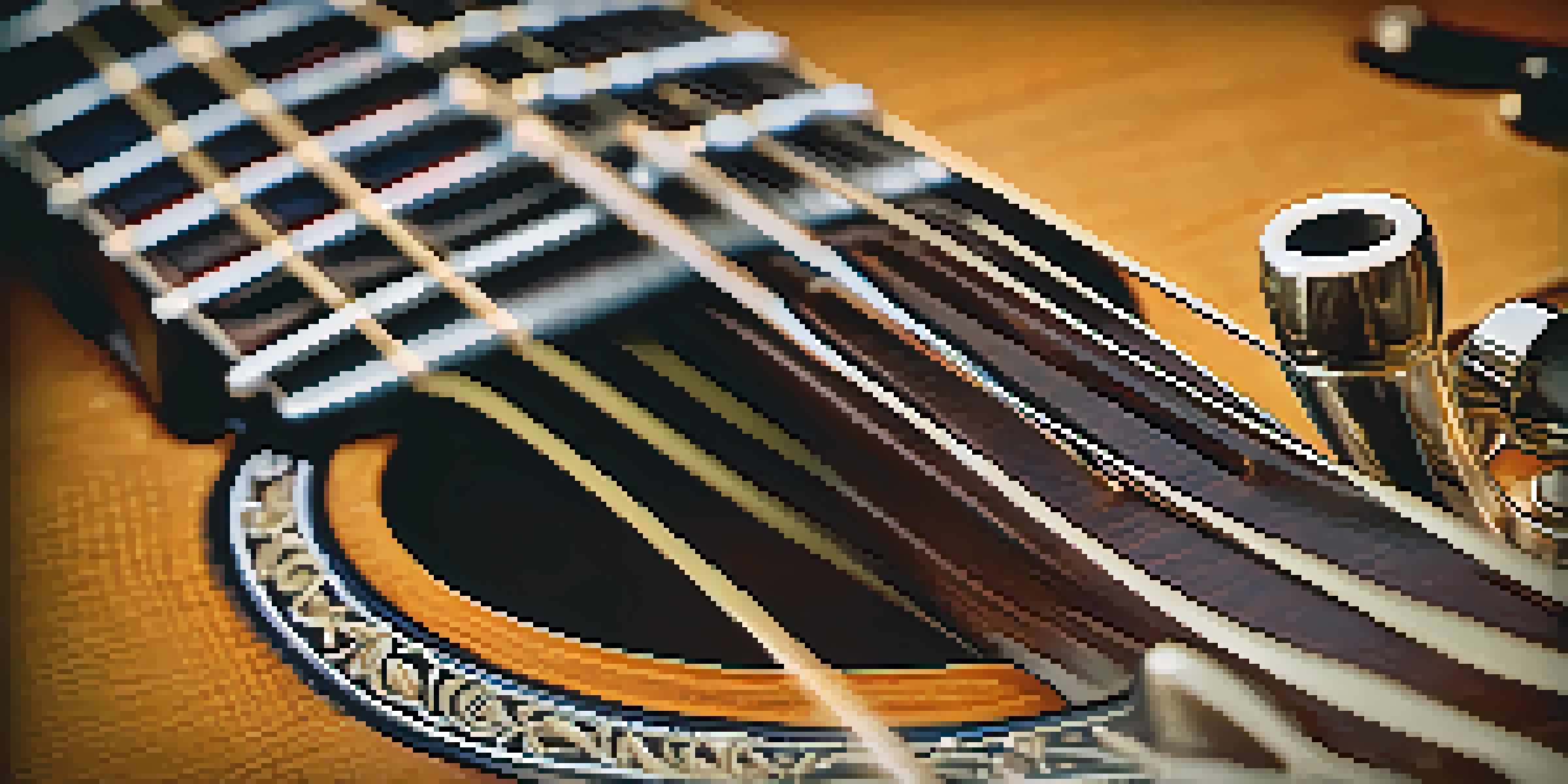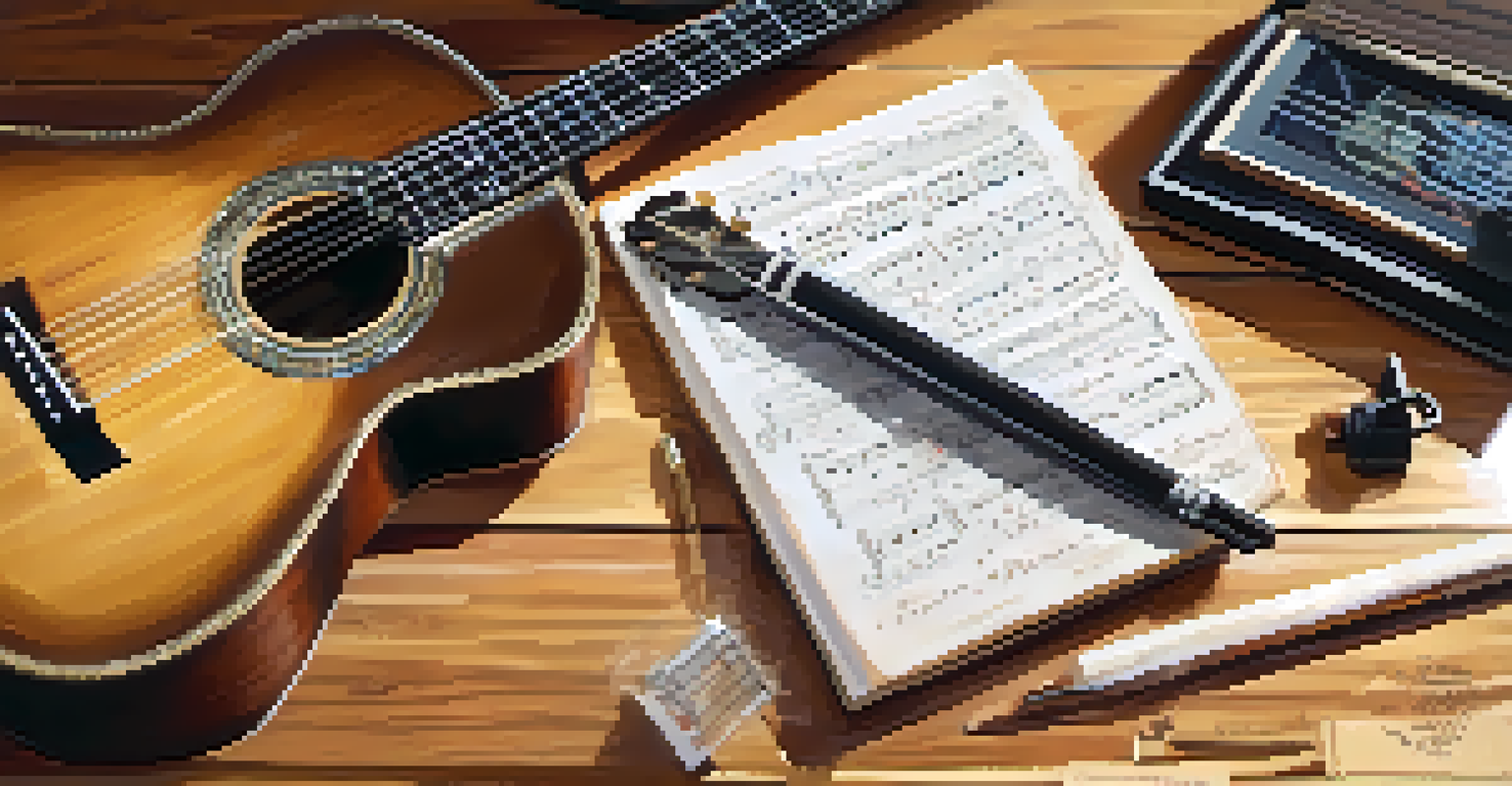Capo Techniques: Transitioning Between Keys Effortlessly

Understanding the Capo: Your New Best Friend
A capo is a simple yet powerful tool that clamps down on the guitar strings, allowing you to change the key of your instrument without having to learn new chord shapes. Think of it as a magical bridge that helps you reach higher musical ground. By raising the pitch of the strings, you can play songs in different keys while keeping the familiar fingerings of your favorite chords.
Music is the shorthand of emotion.
Using a capo opens up a world of possibilities, especially for singer-songwriters who want to adjust their songs to better fit their vocal range. Instead of struggling to hit high notes, you can easily shift the key up or down, all while playing the same chord shapes. This flexibility can make your performances more comfortable and enjoyable.
So, whether you’re a beginner or a seasoned player, learning to use a capo can enhance your creativity and expand your repertoire. As we dive deeper into various techniques, you’ll see just how effortlessly you can transition between keys, making your guitar journey even more fulfilling.
Choosing the Right Capo: Factors to Consider
Not all capos are created equal, and picking the right one can make a significant difference in your playing experience. When choosing a capo, consider the material, design, and how it applies pressure to the strings. A well-made capo will hold the strings down evenly, preventing buzzing and ensuring that each note rings true.

For instance, a spring-loaded capo is easy to use with one hand, making quick key changes during a performance seamless. On the other hand, a trigger-style capo can offer more precise control over string pressure. Don’t forget to consider the size and weight; a lightweight capo can be a great travel companion, while a sturdier design may offer more durability for regular use.
Capo Enhances Musical Flexibility
Using a capo allows musicians to easily change keys while maintaining familiar chord shapes, making it ideal for adapting songs to fit vocal ranges.
Ultimately, the best capo for you depends on your playing style and preferences. Experimenting with different types can help you find one that feels just right, making your transitions between keys more fluid and natural.
Basic Techniques for Using a Capo
Using a capo effectively involves more than just clamping it on the neck of your guitar. Start by placing the capo close to the fret, but not directly on it, to avoid muting the string. This small adjustment can make a significant difference in tone. A good rule of thumb is to position it just behind the fret to get a clean sound.
The beautiful thing about learning is that no one can take it away from you.
Once your capo is in place, practice playing familiar chords in different keys. For example, with the capo on the second fret, a G major chord becomes an A major, and a C major chord shifts to a D major. This technique allows you to explore the same chord progressions in various keys, making your practice sessions more engaging.
As you become more comfortable with your capo, try challenging yourself by learning songs in different keys. This will not only improve your adaptability but also enhance your overall musicianship. With a bit of practice, you'll find that transitioning between keys becomes second nature.
Exploring Open Chords with a Capo
One of the most enjoyable aspects of using a capo is the ability to play open chords in various keys. Open chords, like C, G, D, and A, are the building blocks of many songs, and placing a capo can transform them into new, exciting sounds. For example, if you place a capo on the fourth fret and play an E major chord, it sounds like a G# major.
This technique is particularly useful for guitarists who want to achieve a brighter sound without re-learning complex barre chords. By sticking to open chords, you can maintain that rich resonance while easily shifting keys. This opens the door to countless songs and styles, enhancing your versatility as a musician.
Choosing the Right Capo Matters
Selecting a capo that suits your playing style can significantly improve your guitar experience by ensuring even string pressure and sound quality.
Don't hesitate to mix and match open chords with your capo. Try playing a C major shape with the capo on the second fret, and you'll get a D major sound. This exploration of sound can lead to creative breakthroughs, so keep experimenting with different combinations!
Experimenting with Capo Placement
Capo placement is not just about changing keys; it can also dramatically affect the tone and feel of your music. While most players position the capo right at the desired fret, experimenting with placement can yield interesting results. For example, placing the capo higher up the neck can create a brighter, more ringing sound, enhancing certain melodies.
Consider the emotional impact of different placements. A capo on the fifth fret can add a sense of brightness and energy to a song, while one placed at the seventh fret may impart a more intimate, delicate vibe. This simple shift can change how your audience perceives the music, making it a powerful tool for expression.
As you experiment with different placements, listen closely to how it alters the character of your playing. You might discover new nuances in your favorite songs or even inspire yourself to write original material that leverages these unique sounds.
Combining Capo Techniques with Barre Chords
While open chords are a fantastic starting point, incorporating barre chords into your capo techniques can take your playing to the next level. Barre chords offer more versatility and can fill out your sound, especially in a band setting. When you use a capo in conjunction with barre chords, you can easily play in keys that might otherwise be challenging.
For instance, placing a capo on the third fret and playing an F major barre chord allows you to create a beautiful A major sound. This expands your harmonic capabilities and helps you navigate songs that require a range of chords. Practicing this combination can help you transition seamlessly between different chord types.
Capo Techniques Boost Creativity
Incorporating a capo into your playing can inspire new melodies and harmonies, making it a valuable tool for songwriting and improvisation.
By blending both techniques, you can develop a richer, more complex sound. It not only enhances your repertoire but also gives you tools to express your musical ideas more fully. So grab your capo and start experimenting with barre chords – you might just surprise yourself!
Capo Techniques for Songwriting and Improvisation
Using a capo can spark your creativity, making it a valuable asset for songwriting and improvisation. By changing keys easily, you can explore different tonalities that may inspire fresh melodies or lyrics. This flexibility allows you to step outside your usual patterns and discover new musical ideas.
Consider trying to write a song in a key you’re less familiar with, using your capo to find new chord progressions. When you change the pitch, you might stumble upon unexpected harmonies that could form the backbone of your next hit. Sometimes, a small shift can lead to a big breakthrough in your songwriting process.

Additionally, during jam sessions or improvisation, a capo can facilitate quick key changes, keeping the energy flowing. It allows you to react to other musicians and adapt your playing on the fly, fostering collaboration. So next time you’re stuck in a creative rut, reach for your capo and let it guide you to new musical horizons.